To create an eco-friendly landscape for senior homes, focus on sustainable plant selection with native, low-maintenance species. Implement water conservation strategies like smart irrigation and rainwater harvesting. Use permeable paving for hardscapes and embrace organic gardening practices to enrich soil naturally. Incorporate wildlife habitats to attract birds and butterflies while adding sensory gardens for therapeutic benefits. Design accessible outdoor spaces that promote ease of movement. There's so much more to explore for a vibrant, sustainable environment.
Key Takeaways
- Use native and drought-resistant plants to create low-maintenance gardens that thrive in local conditions while minimizing water usage.
- Incorporate sensory gardens with a variety of colors, textures, and scents to enhance the outdoor experience for seniors.
- Implement rainwater harvesting and smart irrigation systems to conserve water and optimize watering schedules based on weather conditions.
- Design pathways lined with low-maintenance plants to encourage exploration and provide safe, accessible walking areas for seniors.
- Create quiet areas with comfortable seating and soothing water features for relaxation and contemplation in the landscape.
Sustainable Plant Selection
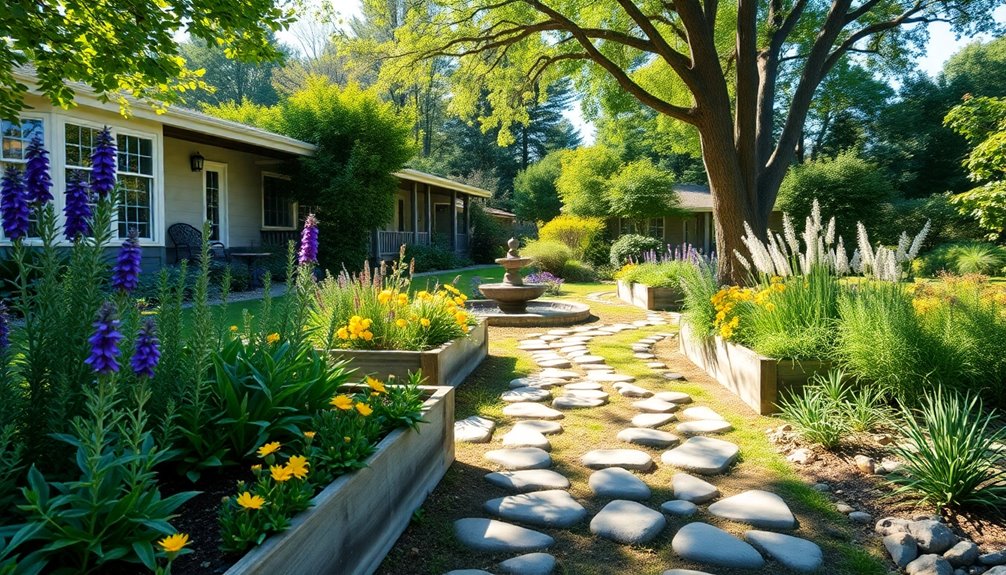
When you choose sustainable plants for senior homes, you not only enhance the beauty of the landscape but also create an environment that's easier to maintain.
Sustainable plant selection focuses on native and drought-resistant species, which thrive in local conditions and reduce the need for fertilizers and pesticides. By incorporating perennial plants, your gardens will return year after year, minimizing replanting efforts.
Choosing low-maintenance options like magnolias and grevilleas guarantees a stunning landscape that aligns with the physical capabilities of older adults.
Additionally, a variety of textures and colors can enrich the sensory experience for seniors, fostering engagement with their gardens.
Water Conservation Strategies

To create a sustainable landscape in senior homes, incorporating effective water conservation strategies is essential. You can start by implementing rainwater harvesting systems to capture and store rainwater for irrigation, which reduces water bills. Smart irrigation systems equipped with weather data can optimize watering schedules, ensuring plants get just what they need.
Consider xeriscaping to design low-water gardens and group plants with similar water needs. Applying mulch can enhance water efficiency by minimizing evaporation. Finally, utilizing drought-resistant plants not only conserves water but also creates a low-maintenance landscape.
| Strategy | Benefits |
|---|---|
| Rainwater Harvesting | Reduces water bills |
| Smart Irrigation | Optimizes watering schedules |
| Xeriscaping | Decreases outdoor water consumption |
| Drought-Resistant Plants | Supports low-maintenance landscapes |
Eco-Friendly Hardscapes

When you think about hardscapes for senior homes, consider options that are both sustainable and functional.
Permeable paving solutions can help manage water runoff, while using recycled materials not only conserves resources but also adds character.
Plus, integrating solar-powered lighting enhances safety and creates a welcoming atmosphere for outdoor spaces.
Permeable Paving Solutions
While many landscaping options can benefit senior homes, permeable paving solutions stand out for their eco-friendly advantages and practical applications.
These surfaces, made from materials like porous asphalt, permeable concrete, or interlocking pavers, allow rainwater to infiltrate the ground. This reduces surface runoff and flood risks, promoting better stormwater management.
By choosing permeable paving, you can cut down on the need for traditional drainage systems, lowering your installation and maintenance costs. Additionally, these options recharge groundwater supplies, supporting local ecosystems and enhancing biodiversity.
Plus, permeable paving improves the aesthetic appeal of garden paths and driveways while providing a safer, slip-resistant surface for older adults. It's a smart choice for both safety and sustainability.
Recycled Material Utilization
Incorporating recycled materials into your hardscapes not only boosts sustainability but also adds unique charm to your outdoor spaces. Recycled material utilization can transform your garden with character while conserving resources. Here are some effective ideas:
| Material Type | Benefits |
|---|---|
| Reclaimed Wood | Ideal for garden beds, reducing waste |
| Salvaged Bricks/Pavers | Adds character, minimizes new material use |
| Recycled Plastic Decking | Weather-resistant, reduces deforestation |
| Crushed Glass/Rubber Mulch | Enhances drainage, low-maintenance |
| Permeable Paving | Promotes groundwater recharge, reduces runoff |
Solar-Powered Lighting Options
Solar-powered lighting options can transform your outdoor spaces, providing both safety and ambiance without straining your budget.
These systems use renewable energy, greatly cutting down electricity consumption and costs for senior homes. Many solar-powered lights come equipped with motion sensors, ensuring energy is only used when needed, which enhances efficiency.
Their durable, weather-resistant materials mean you won't have to worry about constant maintenance, making them ideal for various outdoor conditions.
Plus, installing solar lights can beautify your landscaping by illuminating pathways, garden features, and seating areas, creating inviting spots for seniors to enjoy. Furthermore, integrating renewable energy sources can enhance the overall sustainability of the landscape design.
Organic Gardening Practices
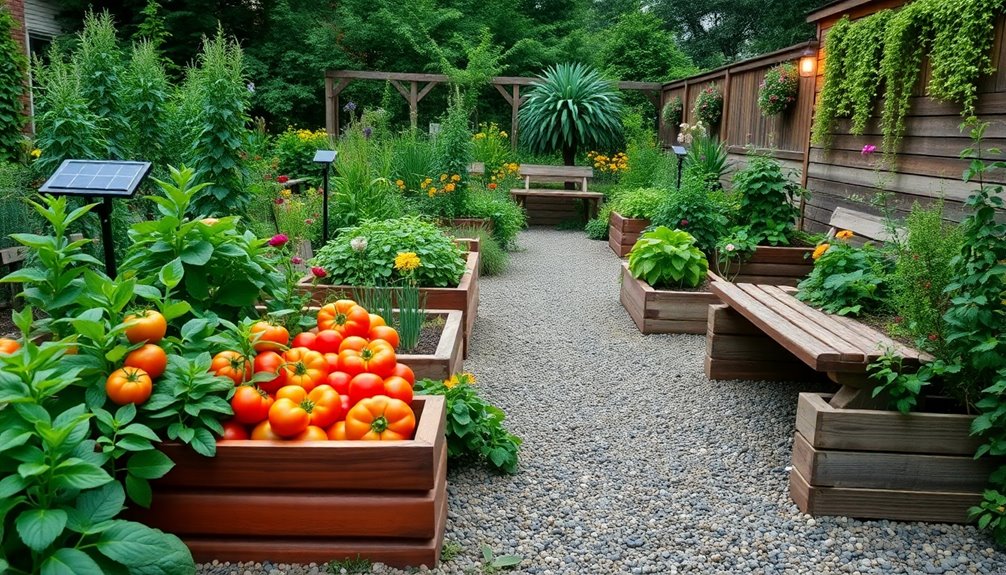
When you embrace organic gardening practices, you'll discover the benefits of composting, which enriches your soil naturally and supports plant growth.
You'll also find effective pest control alternatives that protect beneficial insects and your garden's health.
Plus, focusing on soil health improvement techniques can make your gardening efforts more rewarding and sustainable. Additionally, incorporating eco-friendly practices such as using locally sourced materials can further enhance your gardening experience while supporting the environment.
Composting Benefits for Seniors
Composting offers seniors a fantastic way to recycle organic waste while enriching their garden soil naturally.
The composting benefits for seniors are numerous, including:
- Reducing landfill contributions by recycling kitchen scraps and yard waste.
- Enhancing physical activity through turning and maintaining compost heaps.
- Improving soil structure and water retention, making gardening easier.
- Creating nutrient-rich soil amendments that foster healthier plants.
- Stimulating social interaction with neighbors or community garden initiatives.
Additionally, engaging in composting can help seniors develop sensory processing skills, as they interact with various organic materials and observe the transformation process.
Pest Control Alternatives
Pest control doesn't have to rely on harsh chemicals, especially in senior gardens where safety and health are priorities.
You can explore several effective pest control alternatives that prioritize natural methods. For instance, using neem oil, derived from neem tree seeds, combats various pests without harming beneficial insects.
Introducing ladybugs and lacewings can help, as they naturally feed on common pests like aphids.
Companion planting is another great strategy; for example, marigolds repel nematodes when planted with vegetables.
Additionally, consider using physical barriers like row covers to protect your plants.
Finally, implementing crop rotation and diverse plantings disrupts pest life cycles, fostering a healthier garden ecosystem without chemical interventions.
Embrace these alternatives for a safer, eco-friendly garden!
Soil Health Improvement Techniques
Improving soil health is crucial for creating a thriving garden, especially in senior homes where ease of maintenance is key.
Consider these soil health improvement techniques to enhance your garden's liveliness:
- Compost organic waste to enrich soil with nutrients and improve structure.
- Test your soil regularly to identify nutrient levels and adjust with organic amendments.
- Apply mulch around plants to suppress weeds and retain moisture while enriching the soil.
- Utilize cover crops like clover and vetch during off-seasons to protect against erosion and boost fertility.
- Practice crop rotation to prevent soil depletion and disrupt pest cycles.
Implementing these techniques will lead to a healthier garden that requires less upkeep and provides abundant beauty. Additionally, enriching your soil with anti-inflammatory herbs can support overall plant health and resilience against pests.
Creating Wildlife Habitats
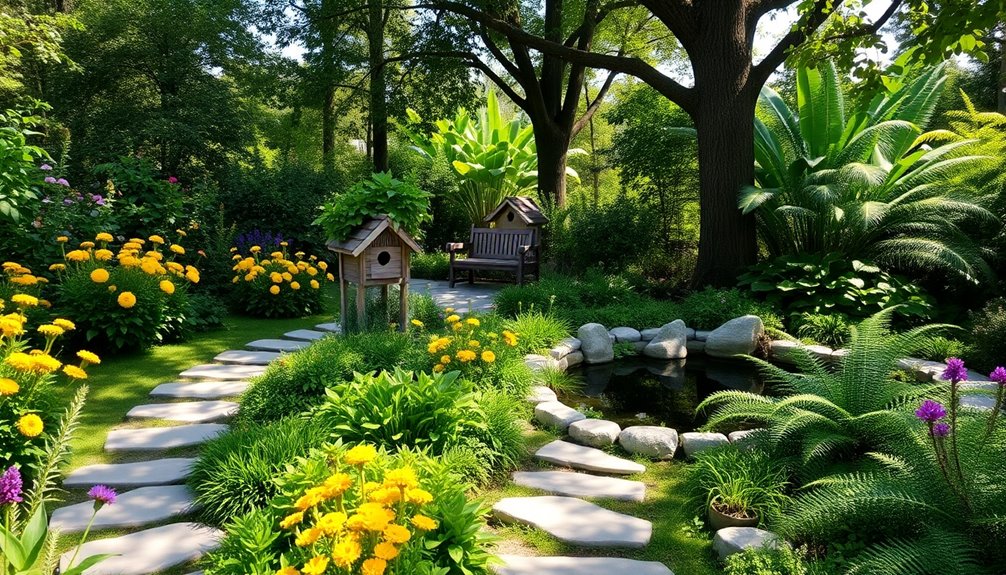
When you create wildlife habitats in senior home landscapes, you not only enhance the beauty of the surroundings but also foster a connection with nature that can be incredibly rewarding.
Incorporating native plants is a great way to attract local wildlife while requiring less maintenance and water. Installing birdhouses and feeders invites various bird species, offering therapeutic benefits through birdwatching.
Creating butterfly gardens with nectar-rich flowers supports pollinators and adds vibrant colors. Consider adding a wildlife pond, which serves as a habitat for aquatic species and a calming feature for relaxation.
Don't forget to plant milkweed to support monarch butterflies, encouraging environmental education and engagement among seniors. Additionally, engaging in these eco-friendly practices promotes environmentally sustainable landscapes that benefit both residents and local ecosystems.
These wildlife habitats enrich the experience for everyone involved.
Incorporating Energy-Efficient Features
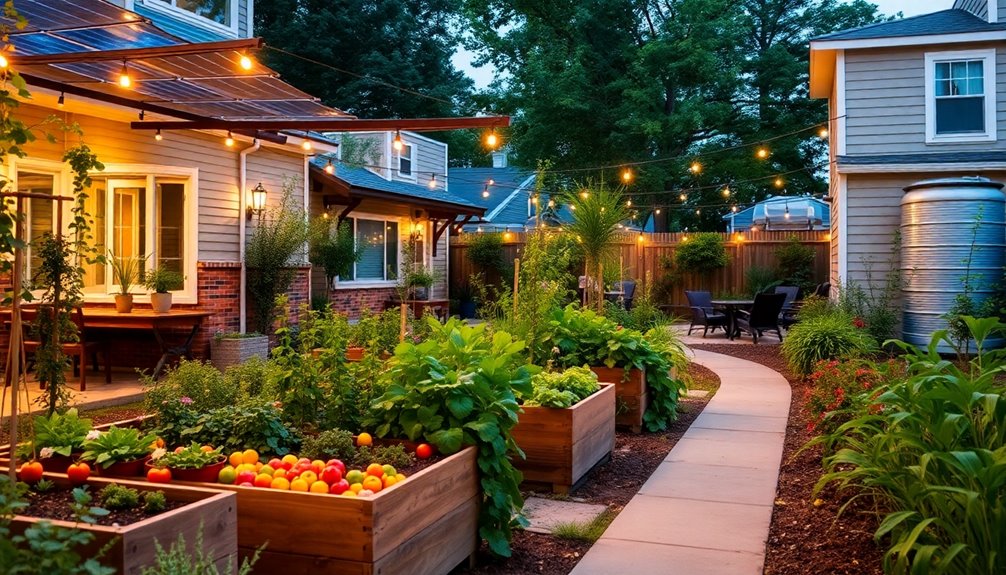
Incorporating energy-efficient features into senior home landscapes not only cuts down on costs but also promotes a sustainable environment.
By adopting these practices, you can create a comfortable and eco-friendly space:
- Install solar panels to reduce energy costs and reliance on non-renewable sources.
- Use LED lighting, which conserves energy and lasts up to 25 times longer than traditional bulbs.
- Implement motion sensors and timers for outdoor lighting, ensuring lights activate only when needed.
- Utilize smart irrigation systems with soil moisture sensors to minimize water waste.
- Enhance accessibility and comfort while fostering a healthier community through energy-efficient features.
Moreover, integrating energy-efficient technology can significantly lower greenhouse gas emissions, further contributing to a sustainable environment.
These changes not only benefit the environment but also enhance daily living for seniors.
Eco-Conscious Maintenance Techniques
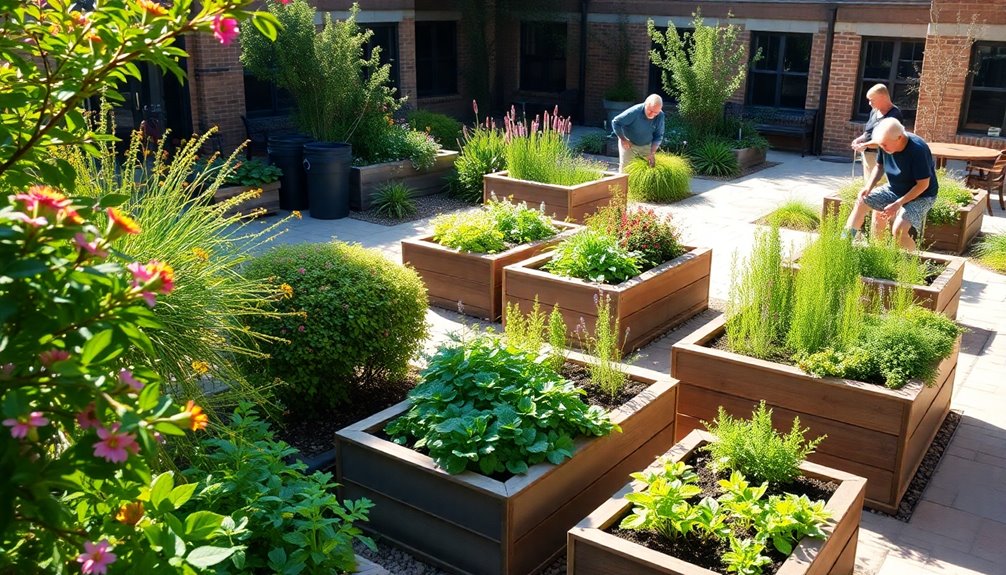
To maintain a vibrant and eco-friendly landscape for senior homes, it's crucial to adopt eco-conscious maintenance techniques that prioritize sustainability and ease of care.
Start by implementing mulching in your gardens, as it retains moisture, suppresses weeds, and reduces watering frequency—making it perfect for low-maintenance areas.
Regular soil testing guarantees a balanced nutrient profile, helping plants thrive without chemical fertilizers.
Seasonal plant care practices, like pruning and deadheading, boost resilience and efficiency, keeping plants healthy year-round.
Encourage community involvement in garden upkeep, fostering shared responsibility and awareness of sustainable practices.
Finally, utilize organic gardening methods, such as composting, to enrich the soil naturally and support local wildlife.
These strategies create a thriving, eco-friendly environment for everyone.
Therapeutic Landscaping Elements
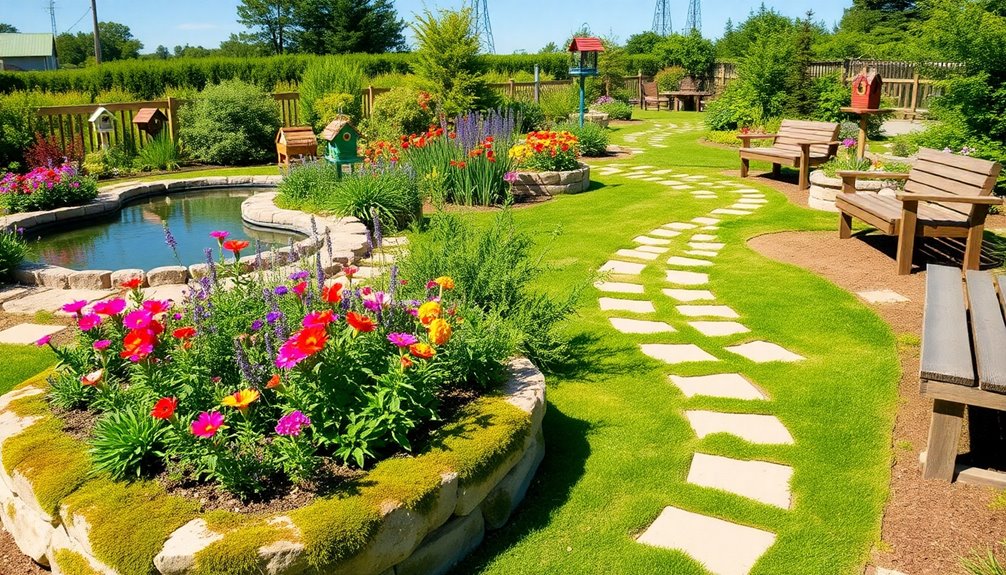
Therapeutic landscaping elements can transform senior homes into vibrant sanctuaries that foster well-being. By integrating these elements, you can create spaces that stimulate the senses and promote relaxation.
Consider incorporating:
- Sensory gardens with fragrant, colorful, and textured plants
- Water features like fountains or small ponds for soothing sounds
- Quiet areas equipped with comfortable seating for contemplation
- Raised garden beds to allow accessible gardening activities
- Pathways lined with native, low-maintenance plants for exploration
These therapeutic landscaping elements not only enhance cognitive engagement but also encourage emotional health and physical activity.
Enhancing Aesthetics With Native Plants
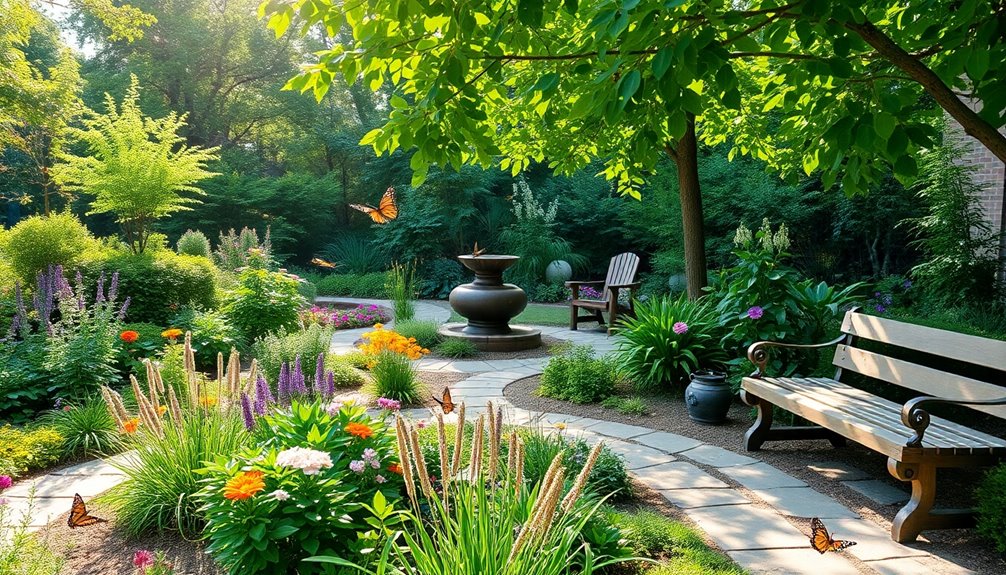
Incorporating native plants into your landscaping not only beautifies the space but also reduces maintenance efforts.
These plants thrive in local climates, offering vibrant colors throughout the seasons while attracting beneficial wildlife.
Native Plant Benefits
When you choose native plants for landscaping, you not only create a beautiful environment but also support a sustainable ecosystem.
These plants thrive in local climates, making them low-maintenance and water-efficient—ideal for senior homes. Plus, they attract local wildlife, enhancing the vibrant atmosphere.
Here are some key benefits of using native plants:
- Require less water and maintenance
- Attract birds and butterflies, enriching the landscape
- Offer diverse colors and textures year-round
- Reduce the need for chemical fertilizers and pesticides
- Increase property values, boosting appeal for senior living facilities
Additionally, fostering a sustainable landscape with native plants can contribute to increased investment in eco-friendly initiatives.
Seasonal Color Variation
A vibrant garden filled with native plants can transform senior homes by offering stunning seasonal color variations that engage the senses. By incorporating plants like purple coneflowers in summer and goldenrod in fall, you create visual interest throughout the year while supporting local ecosystems.
Native plants require less maintenance and adapt well to local climate conditions, ensuring consistent displays without extensive care. Mixing deciduous and evergreen plants guarantees year-round color variation, with evergreens providing structure during winter.
This vibrant garden can also attract pollinators, enhancing biodiversity. Seasonal color changes can greatly improve mental well-being for seniors, encouraging exploration and interaction with a dynamic outdoor environment. Additionally, native plants promote resilience in the local ecosystem, which is essential for maintaining a healthy environment.
Embrace the beauty of native plants for a thriving, colorful landscape!
Designing Accessible Outdoor Spaces
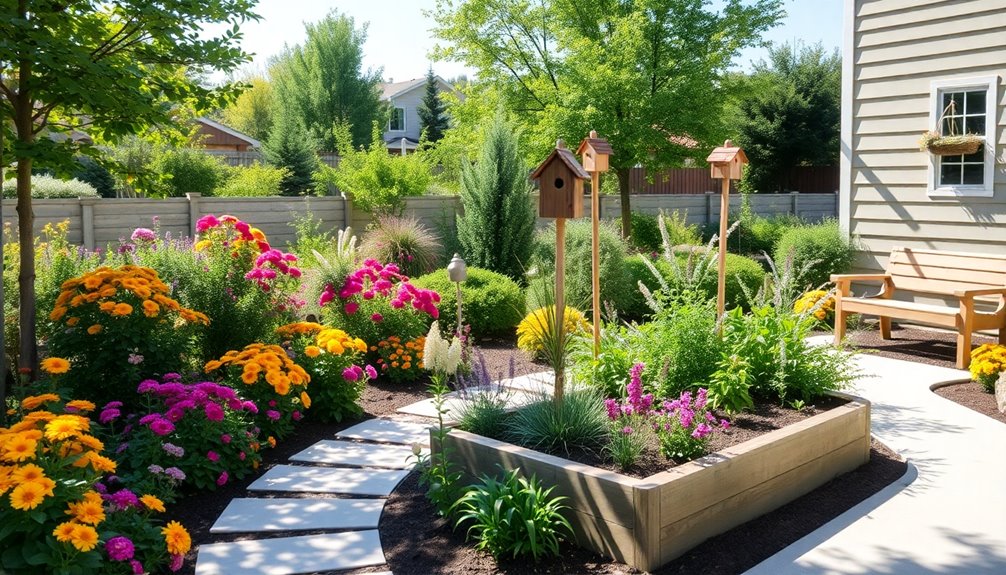
Creating accessible outdoor spaces for senior homes is essential for fostering independence and enjoyment in nature.
Thoughtful landscape design can make a significant difference. Here are some key features to take into account:
- Clear pathways that are spacious and unobstructed for easy navigation.
- Raised garden beds at accessible heights, allowing for comfortable gardening.
- Multiple stable seating options throughout the garden for rest and social interaction.
- Shaded areas to protect seniors from sun exposure and heat-related issues.
- Lightweight gardening tools to reduce injury risks and promote independence.
Frequently Asked Questions
What Is the Most Low Maintenance Landscaping?
The most low-maintenance landscaping focuses on native plants that thrive in your local climate, requiring less water and care.
You'll want to incorporate perennials like daylilies, which come back year after year without replanting.
Drought-tolerant species can minimize watering, while hardscaping features like gravel paths reduce mowing.
Finally, mulching around your plants conserves moisture and suppresses weeds, making it easier for you to maintain a beautiful, hassle-free garden.
How to Design a Sustainable Landscape?
To design a sustainable landscape, start by choosing native plants that require less water and maintenance.
Incorporate rainwater harvesting systems for irrigation, helping you conserve water and reduce bills.
Use xeriscaping principles to select drought-resistant species, minimizing outdoor water use.
Opt for permeable paving to allow rainwater to seep into the ground and enhance groundwater recharge.
Finally, include sensory plants to create an engaging outdoor space that appeals to everyone's senses.
How Can I Landscape Without Water?
You can landscape without water by implementing xeriscaping techniques.
Start by choosing drought-resistant plants like succulents and native grasses that thrive in dry conditions.
Use mulch to retain soil moisture and suppress weeds, cutting down your watering needs considerably.
Consider installing rainwater harvesting systems to capture and store rain for irrigation.
Group plants with similar water needs together to create efficient microclimates, maximizing moisture use while minimizing reliance on water.
What Is the Cheapest Landscaping Option?
The cheapest landscaping option is to use native plants. They thrive in your local conditions, requiring less water, fertilizer, and maintenance.
Instead of annuals, consider perennials; they'll return each year without replanting costs. Incorporating mulch will help reduce watering and weeding, saving you money on supplies.
You can also tackle DIY projects with recycled materials to cut expenses further. Overall, these strategies will keep your landscaping budget-friendly and manageable.
Conclusion
By embracing these eco-friendly landscaping ideas, you're not just enhancing the beauty of your senior home; you're cultivating a sanctuary that nurtures both nature and well-being. Imagine transforming your outdoor space into a vibrant oasis where sustainable practices thrive, encouraging relaxation and connection with the environment. Each thoughtful choice you make contributes to a greener future, ensuring that your garden remains a cherished retreat for generations to come. Let's grow a legacy of love for our planet together.









